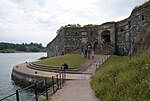Isosaari
Finnish NavyGulf of FinlandIslands of HelsinkiMilitary installations of FinlandNeighbourhoods of Helsinki

Isosaari (Swedish: Mjölö) is an island in Helsinki, part of the Ulkosaaret district of the city, more specifically of Itäsaaret, i.e. ‘eastern islands’. It was one of the fortified islands of the Gulf of Finland. Isosaari is one of the outermost islands in the Helsinki region, and it is a site that is important from the perspective of cultural history. Its sights and its nature are unique.
Excerpt from the Wikipedia article Isosaari (License: CC BY-SA 3.0, Authors, Images).Isosaari
Reimantie, Helsinki Ulkosaaret (Southeastern major district)
Geographical coordinates (GPS) Address Nearby Places Show on map
Geographical coordinates (GPS)
| Latitude | Longitude |
|---|---|
| N 60.1 ° | E 25.05 ° |
Address
Reimantie
Reimantie
Helsinki, Ulkosaaret (Southeastern major district)
Finland
Open on Google Maps









